- Home
- Publications et statistiques
- Publications
- Monthly Business Survey – Start of June ...
The Banque de France publishes a range of monthly and quarterly economic surveys that provide a snapshot of the French economy in the form of business climate indicators and short-term forecasts.
According to the business leaders surveyed (approximately 8,500 companies and establishments questioned between 27 May and 4 June), activity in May declined significantly, mainly on account of holidays and closures linked to the timing of public holidays. This concerned industry and, to a lesser extent, market services and construction. In June, business leaders expect activity to pick up in all three sectors, with a more marked increase in industry. However, order books continue to be deemed weak in industry, with the exception of aeronautics.
Our uncertainty indicator, which is based on comments by businesses, has declined in all three sectors, but more moderately in industry, which is more exposed to the international environment. The impact of US tariff increases on business volumes is regularly mentioned by business leaders in the agri-food (wines and spirits), chemicals, woodpaper-printing, and apparel-textiles-footwear (luxury goods) sectors. For certain activities in market services, companies also report indirect repercussions, particularly in advertising and temporary work.
Raw material prices are considered stable in industry, and supply difficulties remain low overall, except for transport equipment. Selling prices are broadly stable in industry and services, and are declining in construction. Recruitment difficulties are fairly stable at 19%.
Based on the survey results, together with other indicators, we estimate that GDP should grow at the same pace in the second quarter of 2025 as in the previous quarter, by around 0.1%.
1. In May, activity declined in all three sectors, mainly due to the timing of public holidays
In May, activity in industry declined sharply, and more strongly than expected by business leaders, after four consecutive months of growth at levels above or equal to the long-term average. The fall was mainly due to holidays and closures linked to the timing of public holidays in May this year (May 1 and 8). The other industrial products, automotive, rubber and plastic products, machinery and equipment, and metal and metal products subsectors decreased markedly, while agri-food and electrical equipment continued to grow, as did pharmaceuticals and IT products, albeit at a more moderate pace.
The capacity utilisation rate (CUR) for industry as a whole dropped to 75% in May (compared with 75.6% in April),
moving further away from its long-term average (77.2%).
It declined more sharply in chemicals (down 4 percentage points), other industrial products and metal and metal products (down 2 percentage points).
CAPACITY UTILISATION RATE
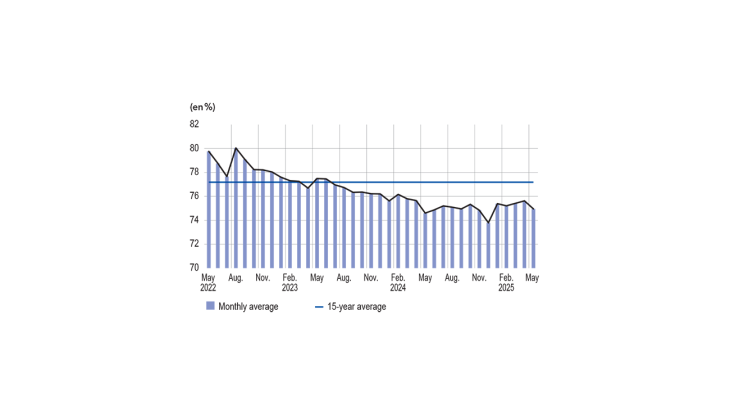
BALANCE OF OPINION ON THE OUTLOOK FOR ACTIVITY

the past month) stood at -9 percentage points for May in industry. For June (light blue bar), business leaders in industry expect activity to increase by 3 percentage points.
Inventories of finished goods were deemed to be down compared to April. They fell sharply in the rubber and
plastic products and aeronautics sectors. In most sectors, however, the balance of opinion on inventories was well
above its long-term average, with the exception of rubber and plastic products.
In market services, activity was down, in line with business leaders’ expectations in April. It declined in management consulting and in leisure activities and personal services. Activity continued to decrease in the vehicle rental sector, as well as in temporary work, due in particular to weak demand from the construction and automotive sectors. However, it remained buoyant in accommodation and food services thanks to the long weekends. Finally, it strengthened in the cleaning sector and rebounded strongly in vehicle repairs.
In construction, activity in the finishing works sector declined more sharply in May than business leaders had expected in April. They reported cumulative delays in various trades, linked to public holidays and sometimes unfavorable weather. At the same time, activity in structural works picked up, at a more moderate pace than in April, but more strongly than business leaders had expected (construction for the aeronautics and military sectors).
The balance of opinion on cash positions in industry remained unchanged, at a slightly negative level. It deteriorated mainly in electrical equipment, agri-food, and pharmaceuticals. However, it improved in chemicals, rubber and plastic products, and apparel-textiles-footwear.
INVENTORIES OF FINISHED GOODS IN INDUSTRY
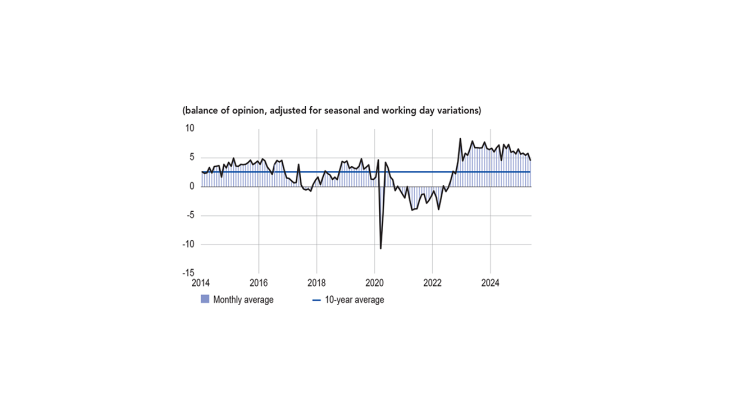
This balance of opinion was still below its long-term average in all industrial sectors. It was deemed particularly low in electrical equipment, rubber and plastic products, and metal and metal products, due in particular—depending on the companies concerned—to longer payment terms.
In market services, the balance of opinion on cash positions was stable at close to zero, although it varied widely across sub-sectors. The cash position was deemed to be satisfactory in publishing and motor vehicle rental. However, it was deemed to have deteriorated in accommodation and food services, vehicle repairs and several business services, particularly advertising, programming and management consulting.
CASH POSITION
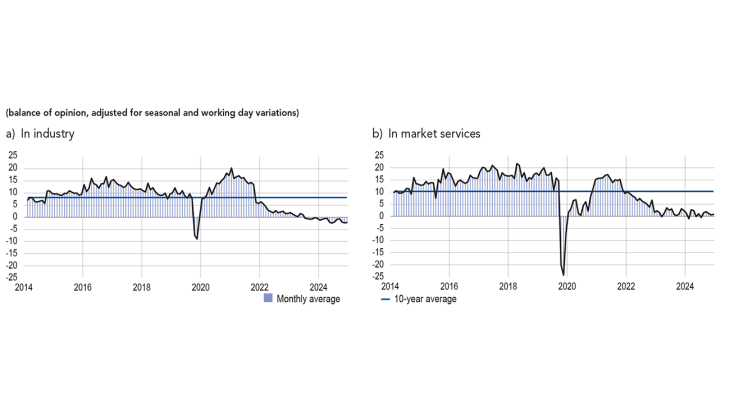
2. In June, business leaders expect activity to pick up significantly in industry and more moderately in services and construction
In June, business leaders expect activity to rebound after the sharp decline recorded in May. Overall, it should grow in all sectors with the exception of apparel-textiles-footwear. The recovery was particularly marked in aeronautics, machinery and equipment, and metal and metal products.
In market services, activity is expected to increase slightly in June, with wide variations across sub-sectors. It should grow in publishing and most business services, particularly in engineering, legal and accounting activities, management consulting, and accommodation and food services. However, it is expected to continue to decline in the vehicle rental and temporary work sectors.
Finally, in construction, activity is expected to pick up moderately, boosted by finishing works, after a sharp decrease in May, with little change in structural works.
At the end of May, industrial order books were still weak (well below their long-term average) in all sectors with the exception of aeronautics, where they remained at a very high level. They were particularly weak in rubber and plastic products, chemicals, the automotive industry, and appareltextiles-footwear. Uncertainty over US tariffs was perceived as causing customers to adopt a wait-and-see attitude, particularly for luxury goods companies.
In construction, the opinion on order books continued to improve in the structural works segment, although it was still negative. It remained slightly negative in the finishing works segment. Business leaders emphasised that the fall in interest rates had not yet had the expected impact on household demand for housing (apartments and single-family homes).
Our monthly uncertainty indicator, which is constructed from a textual analysis of comments by surveyed companies, declined unevenly across the three sectors and remained relatively high in industry, which is more exposed to the international environment. Business leaders referred to the effect of US tariff increases on business volumes particularly in certain segments of the agri-food industry (wines and spirits), chemicals, wood-paper-printing, and apparel-textiles-footwear (luxury goods companies). In certain market services activities,
companies also reported indirect repercussions, particularly in advertising and temporary work.
LEVEL OF ORDER BOOKS
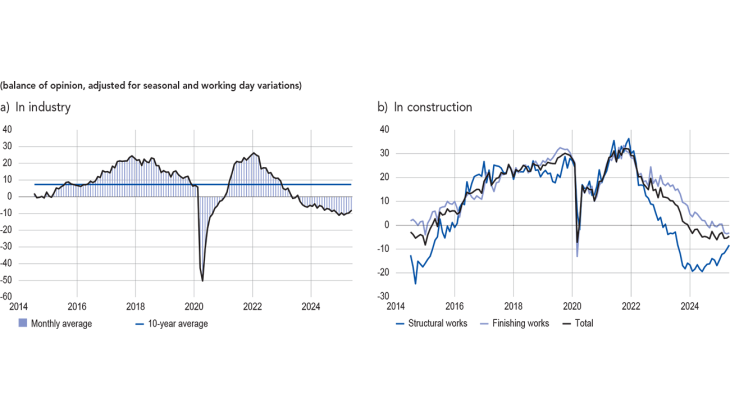
INDICATOR OF UNCERTAINTY IN THE COMMENTS SECTION OF THE MONTHLY BUSINESS SURVEY (MBS)

3. Selling prices were broadly stable in industry and services, and declined in construction
In May, supply difficulties remained broadly stable compared with the previous month (9% of companies reported them, as in April). In the transport equipment sector, which was the most affected, they were still relatively high (they were reported by 20% and 30% of companies in the automotive and aerospace industries, respectively), as a result of persistent tensions on several types of spare parts. Supply difficulties in construction remained rare (3%).
In industry, business leaders considered that raw material prices were stable, with increases in the wood, paper and printing, agri-food and electrical equipment sectors offset by declines in rubber and plastic products and other industrial products. The balance of opinion on finished goods prices1 was also stable, albeit with some differences across sectors. It dropped significantly in chemicals (due to Chinese competition and tougher negotiations with US customers to offset tariff increases) and more moderately in the automotive industry. In contrast, it increased in agri-food and wood-paper-printing (reflecting higher raw material prices).
More specifically, 6% of business leaders in industry reported that they had raised their selling prices in May,
close to pre-Covid May figures and below the same month between 2021 and 2023. Price increases were most widespread in wood, paper and printing (14%) and aeronautics (12%). Conversely, 4% of business leaders in industry reported that they had lowered their selling prices, also close to the pre-Covid May figures. Price decreases for finished goods concerned chemicals (17%) and other manufacturing industries (8%).
In construction, the balance of opinion on price movements remained negative in May, driven by the decline in finishing works. 4% of business leaders reported increasing their quote prices, which was less than the level observed in May of previous years. Conversely, 10% of business leaders (8% in May 2024) reported lowering their quote prices, a much higher proportion than in May of previous years.
In services, the balance of opinion remained very slightly positive. The share of companies reporting price increases was 7%, in line with pre-Covid May figures and below those for 2021-23. Price increases mainly concerned accommodation and food services and programming services. At the same time, the share of companies reporting price decreases was 4%, on a par with figures reported in May of previous years.
CHANGE IN PRICES OF FINISHED GOODS BY MAJOR SECTOR
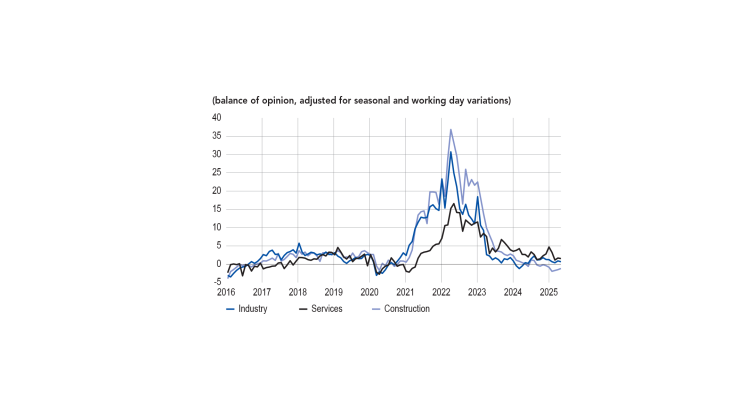
In May, 19% of business leaders reported recruitment difficulties, the same proportion as in April. These were still
highest in construction and lowest in industry, while those in services were close to the overall average.
SHARE OF BUSINESSES REPORTING RECRUITMENT DIFFICULTIES
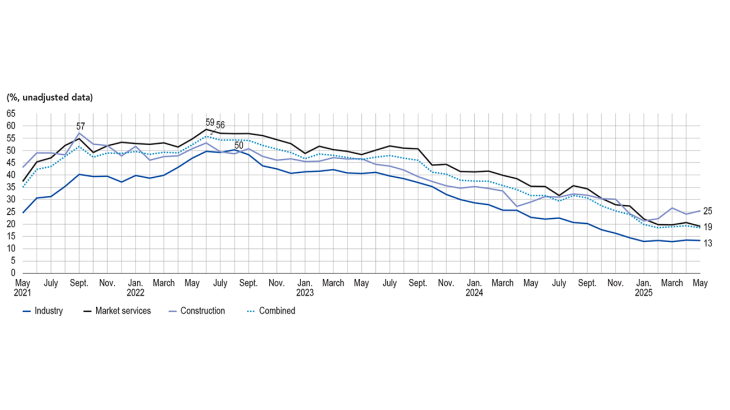
4. Our estimates suggest that GDP will edge up in the second quarter, by around 0.1%
The detailed results of the quarterly accounts published by INSEE at the end of May confirmed that GDP growth
was 0.1% in the first quarter of 2025, with a rebound in the manufacturing sector and a more moderate increase in market and non-market services. Activity declined in the energy and construction sectors.
Based on the results of the Banque de France monthly business survey (MBS), rounded out by other available data (INSEE service and industry production indices and surveys and high-frequency data), we forecast that GDP will grow slightly in the second quarter, by around 0.1%. GDP growth should be mainly supported by the moderate increase in value added in market and non-market services. Value added is expected to decline in manufacturing, as suggested by the decline in the industrial production index in April and in the business survey balances in this sector in May. Finally, activity is expected to decrease further in the construction and energy sectors.
QUARTERLY CHANGES IN GDP AND VALUE ADDED IN FRANCE
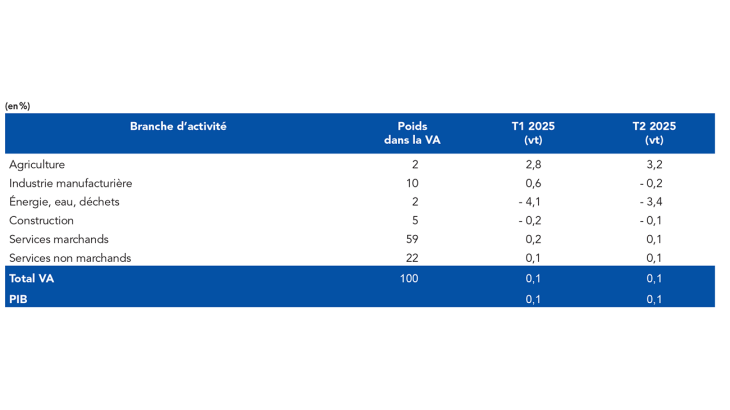
Sources: INSEE data for the first quarter 2025, Banque de France forecast for the second quarter of 2025
1 The balance of opinion is the difference between the proportion of business leaders reporting increases or decreases, weighted by the intensity of the variation (with three possible grades in the monthly business survey: low, normal and high). A business leader indicating a “high” increase in prices will,all other things being equal, influence the balance of opinion more than a business leader indicating a “low” increase.
Download the full publication
Updated on the 20th of June 2025